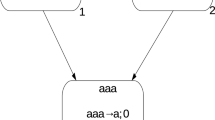Abstract
We look at the recently introduced neural-like systems, called SN P systems. These systems incorporate the ideas of spiking neurons into membrane computing. We study various classes and characterize their computing power and complexity. In particular, we analyze asynchronous and sequential SN P systems and present some conditions under which they become (non-)universal. The non-universal variants are characterized by monotonic counter machines and partially blind counter machines and, hence, have many decidable properties. We also investigate the language-generating capability of SN P systems.








Similar content being viewed by others
Explore related subjects
Discover the latest articles, news and stories from top researchers in related subjects.References
Cavaliere M, Egecioglu O, Ibarra OH, Ionescu M, Păun Gh, Woodworth S (2007) Asynchronous spiking neural P systems; decidability and undecidability. Proceedings of DNA13, LNCS 4848. Springer
Chen H, Ionescu M, Păun A, Păun Gh, Popa B (2006) On trace languages generated by (small) spiking neural P systems. Pre-proc 8th workshop on descriptional complexity of formal systems, June 2006
Chen H, Freund R, Ionescu M, Păun Gh, Pérez-Jiménez MJ (2007) On string languages generated by spiking neural P systems. Fundam Informaticae 75(1–4):141–162
Chen H, Ionescu M, Ishdorj T-O, Păun A, Păun Gh, Pérez-Jiménez MJ (2008) Spiking neural P systems with extended rules: Universality and languages. Nat Comput (special issue devoted to DNA12 Conf). doi:10.1007/s11047-006-9024-6
Gerstner W, Kistler W (2002) Spiking neuron models. Single neurons, populations, plasticity. Cambridge University Press
Greibach S (1978) Remarks on blind and partially blind one-way multicounter machines. Theor Comput Sci 7(3):311–324
Harju T, Ibarra O, Karhumaki J, Salomaa A (2002) Some decision problems concerning semilinearity and commutation. J Comput Syst Sci 65:278–294
Ibarra OH, Woodworth S (2006) Characterizations of some restricted spiking neural P systems. Proceedings of 7th workshop on membrane computing. LNCS 4361:424–442
Ibarra OH, Woodworth S (2007a) Characterizing regular languages by spiking neural P systems. Int J Found Comput Sci 18(6):1247–1256
Ibarra OH, Woodworth S (2007b) Spiking neural P systems: some characterizations. Proceedings of 16th international symposium on fundamentals of computation theory. Springer LNCS 4639:23–37
Ibarra OH, Woodworth S, Yu F, Păun A (2006) On spiking neural P systems and partially blind counter machines. Proceedings of 5th international conference on unconventional computation, LNCS 4135, Springer, Berlin, pp 113–129
Ibarra OH, Păun A, Păun Gh, Rodríguez-Patón A, Sosik P, Woodworth S (2007) Normal forms for spiking neural P systems. Theor Comput Sci 372(2–3):196–217
Ionescu M, Păun Gh, Yokomori T (2006) Spiking neural P systems. Fundam Informaticae 71(2–3):279–308
Maass W (2002) Computing with spikes. Special Issue on Foundations of Information Processing of TELEMATIK 8(1):32–36
Maass W, Bishop C (eds) (1999) Pulsed neural networks. MIT Press, Cambridge
Păun Gh (2002) Membrane computing—an introduction. Springer, Berlin
Păun A, Păun Gh (2007) Small universal spiking neural P systems. BioSystems 90(1):48–60
Păun Gh, Pérez-Jiménez MJ, Rozenberg G (2006) Spike trains in spiking neural P systems. Int J Found Comput Sci 17(4):975–1002
The P Systems Web Page (2008). http://www.ppage.psystems.eu. Accessed on 21 October 2004
Acknowledgements
This research was supported in part by NSF Grants CCF-0430945 and CCF-0524136.
Author information
Authors and Affiliations
Corresponding author
Rights and permissions
About this article
Cite this article
Ibarra, O.H., Woodworth, S. Characterizations of some classes of spiking neural P systems. Nat Comput 7, 499–517 (2008). https://doi.org/10.1007/s11047-008-9084-x
Published:
Issue Date:
DOI: https://doi.org/10.1007/s11047-008-9084-x




